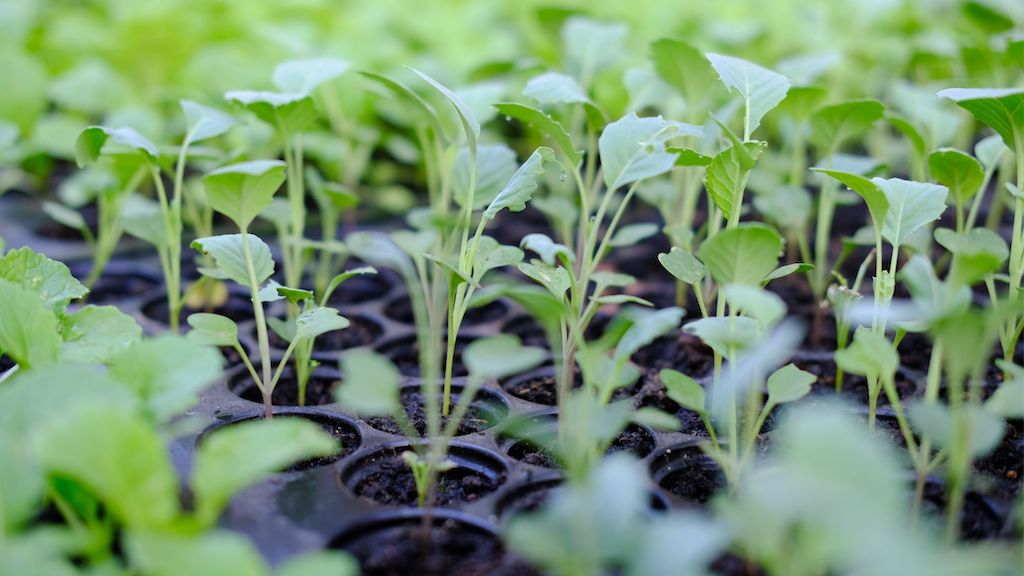There are so many benefits of growing your own microgreens at home. You do not need a lot of equipment and materials to grow microgreens. Growing trays are essential equipment, and there are a lot of options available for microgreen growers. Let’s jump in and find out the best trays for microgreens.
*This post contains compensated links. Find more info in my DISCLAIMER. As an Amazon Associate, I earn from qualifying purchases.
What Are Microgreens?
Put simply, microgreens are young green vegetables and herbs. As their name indicates, microgreens only grow to a height approximately one to three inches tall. These “baby plants” and are harvested between the sprout and baby plant stage. With not much growing to do, microgreens are harvested between 7 and 21 days after planting.
Despite their small size, microgreens are packed full of nutrition. On average, they contain higher nutrient and mineral values than mature plants. The high level of nutrients and minerals is thanks to harvesting microgreens at the peak of their growth cycle.

The nutritional value, flavor, and aroma of microgreens make them a great addition to any dish. As a result, microgreens have become increasingly popular among chefs. Microgreens are a tasty addition to salads, sandwiches, meats, and pasta.
What Do You Need To Grow Microgreens?
Thanks to their versatility and health benefits, growing microgreens at home has increased in popularity. There’s no need to have a “green thumb” in order to successfully grow microgreens at home. Best of all, growing microgreens at home is quick and easy, with many varieties ready to harvest in just two weeks.
Regardless of how much or little space you have, you can grow microgreens. So long as you have access to light, including artificial light, you can grow. Outdoors or indoors, microgreens thrive in both environments making them the best plants for even the most novice home grower.
For the first-time home grower, getting started won’t “break the bank”. Either with the help of a microgreen starter kit or DIY set-up, there’s very little equipment needed. Here is what you need to grow microgreens at home:
- Microgreen growing trays
- Microgreen seeds
- Organic potting soil or a seed growing mix medium
- Spray bottle
- Proper lighting
Different Types Of Growing Trays For Microgreens
There are a lot of different types of trays for microgreens. As a result, choosing the ideal tray can be a challenge, especially for a beginner. DIY microgreen trays are easy to use and do not need any experience or special skills. Here is a list of factors to consider when selecting microgreen growing trays.
Durability
Your tray for microgreens should be durable and sturdy. However, durable trays do not come cheap. Flimsy trays are cheap but might not last long. You may also want to move your tray around. If this is the case, then go trays made from durable materials.
Tray Depth
Microgreens grow in very shallow trays, about one to two inches deep. Microgreens do not need a lot of space to grow their roots. Shallow trays need only a small amount of soil. Shallow trays also make harvesting microgreens easier and quick. However, shallow trays for microgreens will need frequent watering. If the ray is deep, reduce your watering frequency.
Holes
There are trays for microgreens with holes and others without. The question is, which one is better? The answer to this is that none is better than the other. It depends on the type of microgreen you want to grow and how you want to grow it. You might also need both. Most microgreens do not need trays with holes. The soil only needs to be moist, and therefore no need for drainage. In such a case, you don’t need to invest in a tray with a hole.
But why are there trays for microgreens with holes? Trays with holes are used when you decide to water your plants from underneath. In this case, you will need a tray with holes and one without. Plant your microgreens in the tray with holes. Then put water in the tray without holes and submerge the tray with holes in it. Let the soil absorb water and remove the tray. This technique eliminates the need for overhead watering, leaving your plant’s stem and leaves dry.
Tray Size
Your tray size will depend on the number of seeds you want to grow. If you consider growing a lot of microgreens, then get a large tray. The space where you want to grow your microgreens will help determine the tray’s size.
Cost
Your budget is also a critical factor to consider when selecting a tray for microgreens. Ensure you get value for your money by getting a perfect balance between the cost and your preferences.
How To Properly Use Growing Trays For Microgreens
To get the best out of your microgreen growing trays, it’s important to use them properly. For starters, ensure that you get your seed spacing correct. It’s recommended to use approximately 10 to 15 grams of microgreen seeds for a 12×20 inch tray. Proper spacing will ensure proper moisture and nutrient absorption resulting in good growth.
Next, use an appropriate tray for indoor and outdoor growing. Remember that you have no control over outdoor conditions. Use a tray that will protect your plants from drastic changes in outdoor conditions such as temperature.
Finally, clean and sterilize your tray for microgreens before planting your next crop. Sterilizing will prevent infections, especially if the previous plants were infected. By reusing old trays, you’ll save time and money.
Best Trays For Growing Microgreens At Home
Making the right decision on which trays to purchase for your needs is frustrating. Here are a reviews to help further educate your buying decision.
1020 Microgreens Growing Trays

The 1020 microgreen growing tray is durable and long-lasting. It is easy to move without having to worry about it twisting, buckling, or splitting. The tray is less prone to breakage due to weight. You will be able to reuse the tray for up to three years. The tray is more suitable for indoor use, eliminating odors during the growing cycle.
EBaokuup 10 Packs Seed Tray

Ebaokuup’s seed trays are durable, non-toxic, and odorless. This package comes with 40 pieces of planting paper and ten sets of seed sprouting trays. The seeds germinate easily without soil and chemical additives. Its double-deck design allows for the inner tray to be easily removed. The inner tray has a small hole for excellent breathability, letting the seeds grow faster.
Handy Pantry 5-Pack Growing Trays

Handy Pantry’s growing trays are super easy to use. Made of durable non-toxic plastic, these 10×2 inch trays are suitable for indoor growing. The trays are suitable for both traditional soil growing as well as hydronic growing. The trays are ideal for growing microgreens, wheatgrass, and other shallow root plants.
LeJoy Garden Seed Sprouter Tray

The LeJoy Garden seed tray is the perfect kit for the beginner home gardener. This all-in-one system takes out all the guesswork with growing at home. The kit come complete with a water collection tray, grid sprouter, and cover. All you need are the seeds and soil. Made of durable BPA-free plastic, the kit is ideal for both indoor and outdoor growing. For anyone looking to test out growing microgreens at home, this is the kit.
Bootstrap Farmer Extra Strength Seedling Trays

There are no frills with the Bootstrap Farmer 1010 seed trays. Made of ultra durable, BPA-free plastic, the trays can be used for a variety of growing needs. Suitable for indoor and outdoor growing, the trays do not have holes, making them ideal for hydroponic growing. A good value for the money, the trays can be used repeatedly with proper maintenance and cleaning.
Finding the right tray for microgreens can be challenging, especially for beginners, because there are so many options. Our buying will provide you with the facts you need to get yourself that suitable tray and start growing microgreens.
FAQs – Trays For Microgreens
The kind (material, size, etc.) of tray you use for microgreens isn’t that important. What is most important is the depth of the tray. Ideally, you want a tray that provides enough depth for your growing medium and plant roots. A good rule of thumb is a tray with at least 2 inches of depth.
You don’t need a microgreen tray with holes. Microgreens are some of the quickest growing plants around. As a result, there’s no fear of them becoming water-logged. Additionally, they have a shallow root system.
